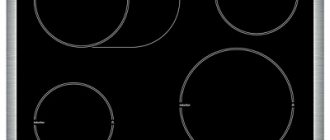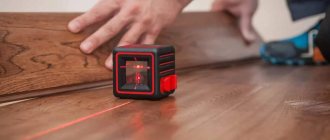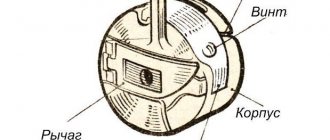One type of home renovation work is replacing and laying ceramic tiles. Tiles are produced in certain standard sizes and do not always, when covering the surface, completely fit into the geometric parameters of the room. There is a need to shorten the decorative product. A tile cutter is designed to perform such operations. To use the tool correctly, you need to familiarize yourself with the device and its application features.
About the tool
Tile cutter is a generalized name for a device designed to perform straight and shaped cuts on ceramic tiles. Several modifications are made:
- Hand tools - pliers (nippers) equipped with a cutting roller.
- Mechanized with manual control.
- Tile cutter with electric drive.
The power of the device is measured by the effort of one person (hand tool) up to several kilowatts for an electric drive. The last option is the professional series.
Mechanized device
It is used for straight cutting of tiles, porcelain stoneware and rock tiles (marble, limestone) followed by breaking along the groove. Some models are equipped with an additional device (“ballerina”) for making curved lines.
Subdivided:
- Roller tile cutter. Designed to perform cutting in a straight line at the required angle. A special feature of the tool is that the carriage and cutting roller move along smooth guides. Support on bushings.
- Manual tile cutter on bearings. The control cutting carriage slides along power rails through a bearing mechanism. The tool is characterized by increased cutting accuracy and long service life.
The thickness of the cut material reaches 15~20mm. The length of the processed tiles is 300~600 mm.
Mechanical and electric tile cutter
Design
Despite the variety of models produced, they consist of common structural units:
- Bed. The supporting part connecting the individual elements of the tile cutter into a common mechanism. The platform plane is designed to fix the material being processed. The design absorbs the forces arising during the cutting process. Hence, the knot must be strong, rigid, and not deform from the applied forces. These properties affect the quality of the processing performed - deflection of the base and vibration will cause curvature of the cutting line and chipping of the tile edges.
- Guides. They define the cutting line and serve as a support for the movable carriage. Models are available with two tubular components or in the form of a monorail.
- Carriage. Combines the control handle, cutting mechanism and support foot.
- Handle (handle). Transfers forces to the cutter and determines the direction of movement. The assembly must withstand significant forces applied to it during the cutting operation.
- The cutter is a cutting roller in the form of a pointed disk made of carbide steel. It is a replaceable part of a tile cutter; a blunt circle with painted edges destroys the workpiece. It cannot be sharpened, so it is replaced with a quality product.
- Paw. Presses and fixes the tile against possible displacement during processing.
This type of tile cutter design is in demand for solving everyday problems during home repairs. A reinforced device, equipped with bearings and with additional functions (protractor, measuring ruler, fixation to a workbench, etc.) is used by professional tile makers.
Electrically driven
This type of tile cutter belongs to the professional series. It features high performance and power. The depth of cut is determined by the size of the cutting wheel. The tool is a type of circular saw with a narrow task - cutting slab materials.
General cutting recommendations
- It is recommended to immerse the tiles in water for 1-4 hours before cutting.
- When marking, it is best to use a thin marker and a metal corner.
- It is recommended to carry out the cut in one step, pressing with equal force along its entire length.
- To ensure that the roller of a glass cutter or mechanical tile cutter moves smoothly, it is lubricated with machine oil.
- An uneven cut is sanded with any abrasive material (sandpaper or mesh, file).
There are many ways to cut floor and wall tiles, it is important to choose the one that best suits your conditions. Power tools and diamond bits are expensive and should only be purchased if there is a large amount of work to be done or if you intend to become a professional tile maker. In all other cases, you can use available tools: glass cutters, tongs, a mechanical tile cutter or an electric drill. The choice is yours!
About tiles
The classic model of a manual tile cutter is designed for cutting ceramic tiles and porcelain stoneware. The listed materials are used for cladding walls and floors in residential and civil premises.
- Ceramic tile. Or tile, in the common name. It is a rectangular plate made of annealed clay. The native color is brown with shades from light to dark tones. The upper part is covered with decorative colored glaze. The average thickness of products is 6~14 mm. Smaller values (6~10mm) correspond to wall-mounted versions, larger values correspond to floor-mounted versions.
- Porcelain tiles. An artificially produced finishing material based on clay, kaolin, sand and spar. It is characterized by high strength and hardness. Technical porcelain tiles resemble natural rock in various color shades. Decorative (artistic) is covered with colored glaze.
Ordinary wall and floor tiles are 1.5~1.7 times inferior in hardness and strength to porcelain tiles. Therefore, when choosing a tile cutter, you need to remember the technical properties of the material being processed.
What and how to cut
Floor and wall materials vary in thickness and strength, so different tools can be used to cut floor and wall tiles.
Various tools can be used to cut tiles
For cutting use:
- Roller or regular glass cutters.
- Tile cutters.
- Angle grinder (grinder).
- Manual (mechanical) tile cutters.
- Electric hand-held devices;
- Professional electric machines;
- Jigsaw (with tungsten thread or abrasive file).
- Electric drills with special attachments.
Working with a manual tile cutter
The operating principle of a roller tile cutter is based on cutting a groove in the body of the tile. The scratch depth does not exceed 0.1~0.4mm. The process is reminiscent of cutting glass with a manual glass cutter.
Fired clay (ceramics) during the manufacturing process acquires a negative property - sensitivity to stress concentrators. In this case, it is a cut groove in the form of a microtriangle. The application of additional external forces causes cracking along the generatrix - the tile is divided into parts.
Tool preparation
The condition of the tile cutter directly affects the quality of the work performed. Hence, before starting work you need to:
- Check and remove dirt deposits from the platform, guides, carriage and foot. The presence of mechanical inclusions can lead to curvature of the cut line and chipping of the tile edges.
- Inspect the tool to identify possible deformations - the curvature of the frame, guides or handle will disrupt the normal processing process.
- Check the condition of the roller - it must be intact, sharp, and free of potholes and burrs. If necessary, replace with a working one. The cutting disk must be securely fixed - rotation is carried out in one plane, without backlash (free movements).
- Perform an idle run to check the coincidence of the roller movement along the central markings on the frame, and make corrective adjustments.
- It is advisable to lubricate the guides or bearings with machine oil - the carriage will slide easier without jamming.
Straight cut
The stage of cutting tiles begins with marking the tiles - the line of the future cut is drawn on the surface with a pencil or marker. It is outlined using a ruler or a carpenter's square.
Further:
- Place the tiles on the surface of the platform and secure. The marking line must coincide with the central axis of the bed.
- Make a “zero” cut - lightly touching the workpiece with the wheel, check that the direction of movement of the roller coincides with the applied markings. Adjust the position of the tile until the axes completely coincide.
- Place the cutter at the starting point - on the edge of the tile.
- Having created a force on the handle from top to bottom, move the carriage “away from you” from the beginning to the end of the workpiece - a quiet, characteristic scraping-rustling sound will be heard.
- Move the foot to the middle of the tile and press the handle with a fairly sharp movement - the ceramic product will split.
Cutting off small parts
A mechanical tile cutter allows you to confidently cut a part at a distance of 10~20 mm from the edge. For smaller sizes, it is advisable to use a manual device - tongs:
- The workpiece is marked.
- Place the support strip on the surface of the tile along the marking line. You can use a flat wooden block or a metal ruler as a guide.
- Draw a groove with a roller.
- Place the tile on a hard, durable surface with a smooth edge, such as a stool, chair or table. The cut part of the tile should protrude 2~5 mm beyond the reference plane.
- Using gentle movements, break off pieces of ceramic using the jaws of the pliers. Sharp edges and irregularities are dulled with a spatula or abrasive stone.
Curvilinear cut
Some models of tile cutters are equipped with a “ballerina” - a circular drill for creating holes:
- Marking is carried out to determine the center of the future hole. Use a ruler, compass, pencil.
- The workpiece is located on the bed. The marking center must be located on the main axis of the platform.
- The “ballerina” is brought in, the main rod with a pointed end is aligned in the center of the circle being performed.
- The circle line is lightly lubricated with oil, the cut is carried out by rotating the handle clockwise.
- The exit of the central drill means that the tile needs to be turned over and drilled from the reverse side. Correct uneven edges with a grinding tool (file, medium-grained or fine sandpaper).
Roller or diamond glass cutter
This device can only cut thin wall tiles; it is not suitable for floor tiles, they are too thick for it. If you need to quickly cut one or several tiles, it is convenient to use. The material is cut by cutting a strip on the front side and then breaking off the desired part. They can cut at least 1/3 of the width of the tiles.
Roller or diamond glass cutter
Cutting tiles with a glass cutter
- The tiles are placed face up on a flat hard surface or the smooth edge of a table so that the planned cut coincides exactly with this edge.
- Mark the cut line with a marker.
- Along this line, draw the glass cutter towards yourself, pressing evenly, a clear stripe should appear on the surface.
- Place a match, pencil, drill or nail under the cut and carefully press the tile on both sides, or rest it along the cut on the edge of the table and break it off.
Advice:
A variation of this device is an oil glass cutter. There is a container installed in its handle, which is filled with a mixture of kerosene and machine oil. The mixture flows through the channel onto the roller, which simplifies the cutting procedure.
Curvilinear cutting
If a curved cut is required, use a roller glass cutter and pliers. To make a cut like this:
- Use a felt-tip pen or marker to mark it on the front side of the product;
- cut along the markings several times with a roller glass cutter;
- Pieces are plucked off little by little with pliers. The closer to the cut line, the smaller the pieces you need to pinch off;
- The cut area is trimmed with sandpaper or a file. This work is labor-intensive and time-consuming.
If you need a curved cut, then use tongs and a glass cutter
The advantages of this tool include simplicity, low price, and speed. But it is difficult to process a large amount of material at one time.
Advice:
If you don’t have a glass cutter or other tool, you can use a metal or concrete drill, a large nail or a construction knife for urgent cutting. They are drawn along the cutting line using a metal corner, in the same way as with a glass cutter (a nail and a construction knife must be drawn several times to obtain a clear groove). After this, place a pencil or drill under the cut line and break the tile.
Safety precautions
A tile cutter, even a manual one, is a source of increased danger. Hence, it is necessary to observe safety measures:
- Read the instructions for using the tool and follow the manufacturer's recommendations.
- Use closed clothing made of durable and dense fabric. Use protective gloves and goggles (mask)
Be sure (!) to check the serviceability of the tile cutter before starting work. A faulty tool is a guarantee of injury and damage to the tiles.
- The tile cutter must be installed on a strong and rigid base that does not create vibrations.
- Avoid excessive force when cutting tiles, as this can lead to deformation of the bed, guides and handle. The carriage or foot may break, as well as cracking of the tiles.
FAQ
- Do you need to wet your tiles? No, dry tiles cut well. Lubricant, in the form of drops of oil, can be added when working with floor tiles or porcelain stoneware.
- Does the cutting speed depend on the force applied? Depends, but partly. Thin, 6~8 mm tiles can simply crack, so clear, uniform movements are more important here. Porcelain tiles will require a lot of effort, but there is a risk of damaging (deforming) the frame or other parts of the tile cutter. It is necessary to choose the “golden” mean, and this comes with work experience.
- Do you need additional support points? Yes, especially when the edge of the tile extends beyond the frame by more than 150~200 mm. In this case, a strong support is placed, comparable in height to the base of the tile cutter, for example, a wooden block or wedges.
- How to cut porcelain tiles? Tiles up to 10~12 mm thick can be cut using a classic tile cutter. This is available to experienced craftsmen who know the behavior of durable materials. For inexperienced users, it is advisable to use a grinder with a diamond wheel.
- How to quickly learn how to use a tile cutter? In general, the operation is quite simple. But here it is important to feel the cutting process itself, learn to control your movements and efforts. For some, one day is enough, for others, a week is not enough. There is only one piece of advice in this case: practice on one or two tiles if you don’t have time for longer practical training.
Mastering the process of cutting tiles yourself is a matter of time and desire. A good helper for this is a manual roller tile cutter. Knowing the properties and geometric characteristics of tiles, you can select the appropriate tool and begin laying ceramics.
Electric drill
If you need to cut shaped holes in the tiles (for sockets, pipes), use a drill.
If you need to make holes in the tiles, you can do this with a drill.
There are three ways to cut holes with a drill: a diamond-coated crown, a ballerina bit, and a thin tile drill.
- Holes cut with diamond crowns are very smooth and of high quality. The better the coating on the crown, the smoother the cut. The only drawback of such crowns is their high price. Crowns should be purchased if you have a lot of holes to drill.
- The ballerina attachment is used at low drill speeds, otherwise chipping may occur. First, mark the center of the circle, adjust the “ballerina” to the desired diameter, carefully cut the tile from the front side, then do the same from the back, and so on until it is completely cut out. The attachment does not last long, about 35–40 cuts, but at home this is enough. The price is much cheaper compared to diamond crowns.
- If you need to cut a large hole, make it with a thin tile drill. First, mark a circle on the front side of the product and drill many holes in a row close to each other. Then the circle is broken out and the cut is smoothed with an abrasive material.











